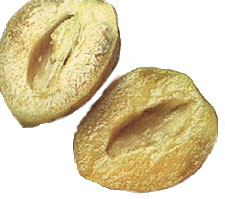
FoodFood InformationFruitTropical
As the demand increases for unusual, pretty produce, fruits such as the
pepino are finding a niche in U.S. markets.
To look at a pepino, you'd never guess it was a melon. Only the flavor
gives it away. Native to South America, this 2 to 4 inch, teardrop-shaped
"bush melon" is now grown in New Zealand and California on a small
scale commercial basis. The exotic-looking skin is marked with purple and
greenish yellow stripes; the flesh is pale yellow-green to yellow-orange,
with a melon-like texture and a flavor like that of a cantaloupe crossed
with a honeydew.
Like other melons, pepinos are relatively low in calories and high in vitamin
C. They are also high in potassium.
Most pepinos are under-ripe when they arrive in the market; their skin is
striped green and purple, and they're very firm. You'll need to ripen them,
until the green skin turns more yellow.
Ripen pepinos at room temperature, uncovered, out of direct sun; turn occasionally.
Refrigerate ripe fruit in a plastic or paper bag for up to 3 days.
Cut pepinos in half length-wise; scoop out and discard seeds. Eat from skin
with a spoon, or peel and slice.
One pepino yields about 1/3 cup sliced fruit.
Pepinos are the perfect size for individual servings at breakfast; sprinkle
with lime or lemon juice to enhance flavor. For appetizers, wrap 1/2 inch
pepino wedges with proscuitto. Add firm-ripe wedges to fruit or spinach
salads.
Like most melons, pepinos are best served uncooked. However, when sauteed,
they make an interesting accompaniment to meats.
Sauteing. Thinly pare peel from pepinos. Halve and seed pepinos, then cut
each half in half lengthwise. Saute until hot and tender when pierced (about
3 minutes).
Available: February through June for New Zealand fruit; August through December
for the California crop.

Deamer 5/97